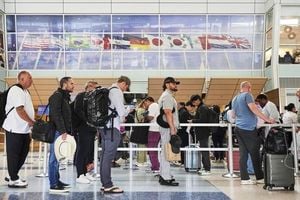On the morning of August 28, 2025, the tranquil halls of Annunciation Catholic Church in Minneapolis were shattered by a horror that has become all too familiar in the American landscape. As schoolchildren gathered for morning worship, a gunman opened fire, unleashing a torrent of violence that left two children dead and 18 others wounded, sending shockwaves through the local community and reigniting fierce national debates over gun control and public safety. According to The Associated Press, the shooter, identified as 23-year-old Robin Westman, entered the church armed with a semiautomatic rifle, a shotgun, and a pistol—all weapons that had been purchased legally under Minnesota law. In a chilling detail, Minneapolis Police Chief Brian O’Hara revealed that Westman’s 5.56 mm rifle discharged 116 rounds in less than four minutes, a grim testament to the destructive power of such firearms.
Chief O’Hara also described how the shooter approached from one side of the church, where some doors had been barricaded with a two-by-four. "So not all of the doors around the building, but on the side the shooter did fire," he explained, painting a picture of a desperate attempt to protect those inside. The attack, which police say ended when Westman died of a self-inflicted gunshot wound, targeted the softest of targets: children and worshippers, gathered in what should have been a sanctuary of peace and safety.
As news of the tragedy spread, the city of Minneapolis—and indeed, much of the nation—was plunged into mourning. The victims included two children, ages 8 and 10, whose lives were cut heartbreakingly short. Seventeen others were injured, including 14 children. The trauma extended far beyond those physically harmed; as Fox News host Trey Gowdy observed during a broadcast on August 28, "even those that survived will be impacted for the remainder of their lives." Gowdy, a former prosecutor and Republican congressman, called the church "the softest of all targets and the most innocent of all victims – children." He continued, "Literally, the whole purpose of the church is to welcome people who are down and out, who are depressed, who feel ostracized. That is the purpose of church. Having said that, there are no words."
Gowdy’s remarks, particularly his assertion that "the only thing that can give us any modicum of peace at all is that those two children are with the person who loved them the very most, the person who created them, that being Jesus," sparked a wave of backlash across the political spectrum. Progressives and liberals took to social media to decry what they saw as a tone-deaf response, with Rolling Stone’s Asawin Suebsang commenting, "I would never think to say this to any devout friend or family member who had just had a kid murdered." Even some conservatives bristled at Gowdy’s subsequent comments about the need to discuss the balance between freedom and protecting children, with right-wing voices on X calling for his dismissal from Fox News.
Beyond the immediate grief and controversy, the shooting has reignited a perennial debate in Minnesota and across the country: how to prevent such tragedies in a society deeply divided over gun rights and regulation. Minneapolis Mayor Jacob Frey, speaking just a day after the shooting, called for sweeping action at both the state and federal level. "I think we’d be happy to ban assault rifles here in Minneapolis," Frey declared. "I know we’d be happy to prevent a next mass shooting from taking place." He urged lawmakers to enact bans on certain semiautomatic weapons and high-capacity magazines, warning that if others failed to act, the city might take matters into its own hands.
Yet, as The Associated Press noted, translating such calls into policy is no easy feat in Minnesota—a state often perceived as reliably Democratic, but in reality marked by a sharply divided government. As of 2025, the state House was split evenly between Democrats and Republicans, while the Senate’s Democratic majority hung by just a single seat. Bryan Strawser, chairman of the Minnesota Gun Owners Caucus, captured the political stalemate: "We have one half of the Legislature that doesn’t believe that gun control is the answer – that there are other policy imperatives. We have another side of the Legislature that goes right to gun control. I don’t think one incident changes that calculus."
Despite existing gun regulations—including permit requirements for certain semiautomatic rifles and pistols, and a "red flag" law enacted in 2024 allowing courts to temporarily remove firearms from those deemed a threat—none of these measures prevented Westman from legally acquiring the weapons used in the attack. This reality has fueled arguments from gun safety advocates who say more must be done. Nick Suplina, Everytown for Gun Safety’s senior vice president for law and policy, was blunt: "The failure to act here is the reason we are once again mourning dozens killed and injured in a school and a house of worship. It is time for Minnesota to regulate assault weapons."
Lawmakers sympathetic to stricter gun laws have signaled a renewed push for reform. Senate Judiciary Committee Chair Ron Latz, a Democrat who has long championed gun safety, announced plans to introduce a comprehensive package of proposals in 2026, including bans on assault rifles and high-capacity magazines. Senate Majority Leader Erin Murphy, while noncommittal, acknowledged, "Minnesotans are clear with us. They are in favor of a ban on assault weapons, and they’re in favor of a ban on high capacity magazines. And it’s time for us to love our children most and do our work." House Democratic Floor Leader Jamie Long expressed regret that more wasn’t done when Democrats held full control in 2024, admitting, "It shouldn’t have taken tragedy coming to Minnesota to be ready. We should have been ready to act then. But we are ready to act now."
The call for action is echoed by those most deeply affected. The family of Melissa Hortman, a former top Democrat in the House who, along with her husband, was killed in June 2025 by a gunman posing as a police officer, issued a poignant statement after the church shooting: "Mark and Melissa believed that children should be able to gather in schools safely, that communities should be able to worship in peace, and that families should be safe in their homes. We hope this tragedy spurs elected officials to take action toward common-sense measures on access to high-powered weapons so that no one else must suffer."
The debate in Minnesota mirrors national trends. A federal ban on certain semiautomatic firearms and large-capacity magazines expired in 2004, and while 11 states and Washington, D.C. have since enacted their own prohibitions, efforts to pass such laws remain contentious. Legal battles continue, with the U.S. Supreme Court recently declining to take up a challenge to Maryland’s ban, even as gun rights advocates press for the Court to hear a case involving Cook County, Illinois. Brandon Combs, president of the Firearms Policy Coalition, argued, "The Supreme Court must end this lawless two-step where politicians ban arms they dislike and judges pretend that’s constitutional to rubber-stamp their policy preferences."
In the wake of the Minneapolis tragedy, communities far beyond Minnesota have responded with solidarity. On August 30, a high school in the northwest suburbs of Chicago held a prayer vigil to honor the victims and support those affected by the shooting, a reminder that the ripples of such violence extend across state lines and touch countless lives.
As Minnesota and the nation grapple with the aftermath, the pain is raw, the questions are urgent, and the path forward remains fiercely contested. But for the families of Annunciation Catholic Church, the need for answers—and for action—has never felt more immediate.




